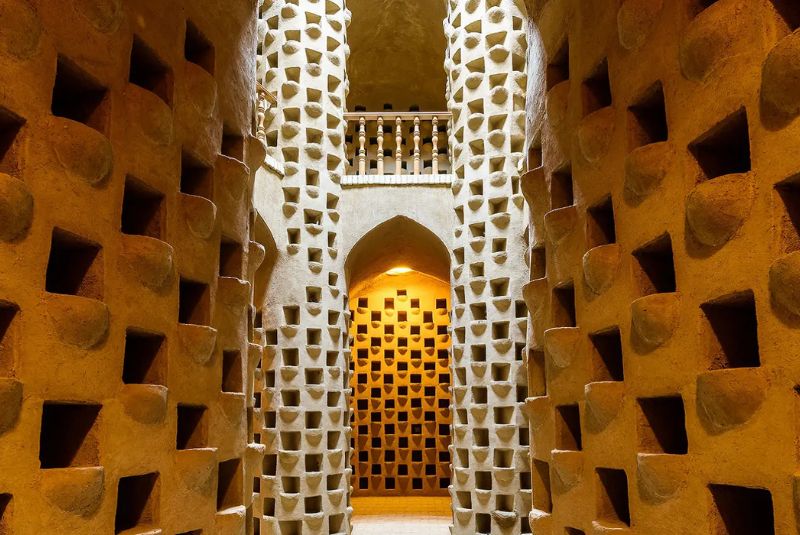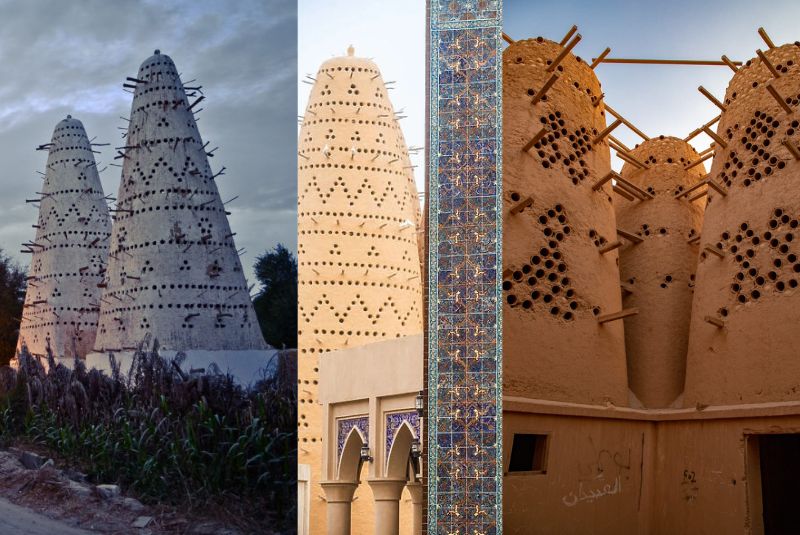Pigeon Towers in Iran | Legacy of Iranian Dovecotes
Imagine towering cylindrical structures, adorned with intricate brickwork, rising from the ancient landscapes of Iran. These structures are not watchtowers or observatories; instead, they are pigeon towers—a captivating expression of human ingenuity from a bygone era.
Built primarily to house and collect guano from pigeons, these unique structures played a vital role in Iranian agriculture and continue to hold cultural significance. Let's explore the history, design, and enduring legacy of these remarkable pigeon towers in Iran.
History of Pigeon Towers in Iran

The story of Iran's pigeon towers stretches back further than previously thought. While the Safavid dynasty saw their peak use (1501-1736 AD), evidence suggests these structures existed as early as 1200 years ago, showcasing a long-standing practice of utilizing pigeon guano for agricultural purposes.
Pigeon training wasn't just prevalent during the Safavid era but extended to the post-Islamic period across several regions. Interestingly, pigeon racing also existed in the 4th and 5th centuries, sometimes creating conflict with residents, leading to the destruction of some towers due to their intrusion on personal spaces.
Iranian agricultural heritage reflects the deep knowledge required for pigeon farming, emphasizing not just their meat but also their manure as valuable resources. Building pigeon houses for both purposes wasn't solely decorative, but driven by a practical need for profit and resource utilization. Even today, the distinctive towers with "hundreds of square holes" highlight this unique agricultural practice.
Historical records and cultural values suggest Iranian pigeon keeping went beyond just meat consumption and focused heavily on utilizing their manure for agriculture. This emphasis might stem from the traditional view in Iranian culture that harming birds is considered sinful.
Another potential reason for prioritizing pigeons lies in their feeding habits. Unlike sparrows and other birds, pigeons primarily target seeds scattered on the ground after harvest, minimizing damage to growing crops. This made them ideal for large-scale breeding, potentially preventing the waste of significant amounts of wheat while also generating valuable pigeon manure.
While pigeons served as a potential meat source in times of famine, their cultural significance and practical benefits likely ensured their safety during normal periods. The primary focus remained their guano, considered highly valuable animal manure. This "precious" fertilizer, as historical accounts describe, was instrumental in nurturing the famous melon fields of Isfahan, a tradition that continued for centuries. Historical records suggest that the pigeon towers in Isfahan showcase a flourishing community of over 3,000 pigeons, underscoring the impressive magnitude of this longstanding tradition.
While prevalent in Iran, pigeon towers weren't unique to the region. Similar structures existed in countries like Afghanistan, Iraq, Turkey, Egypt, and even Western nations like England, France, and Spain. Despite their significant role in agriculture, detailed information about these structures remains somewhat scarce.
The central regions of Iran, particularly the agricultural lands around Isfahan, saw the most construction of pigeon towers. This choice was likely influenced by several factors, including:
- Favorable climatic conditions: The region's climate was suitable for both pigeons and the crops they helped fertilize.
- Thriving agriculture: The extensive agricultural activity created a high demand for fertilizer.
- Need for mass manure: Pigeon towers provided a consistent and efficient way to produce large quantities of manure.
- Limited access to alternative manure: Access to other forms of manure might have been limited throughout the year, making pigeon guano an even more valuable resource.
Finally, the choice of pigeons stemmed from their high-quality manure, considered more effective than other livestock options in boosting agricultural land fertility. Additionally, pigeons were easier and more affordable to maintain compared to other animals.
| Suggestion: Iran's Wildlife | A Nature Lover's Guide + Pics
Exploring Iranian Pigeon Towers

Venture into the heart of Iran and you'll encounter a unique landscape dotted with towering structures, rising like silent sentinels from the sun-baked earth. These are not fortresses or watchtowers, but rather pigeon towers, fascinating testaments to human ingenuity and a bygone era of agricultural practices.
The Isfahan region boasts the highest concentration of these avian abodes, with over 350 peppering the landscape. Typically ranging from 5 to 20 meters in height, these towers offer a glimpse into the remarkable methods employed by the Iranians.
Stepping closer, you'll notice the intricately carved mudbrick that forms the walls of these towers. Small nesting niches, strategically placed around the interior, provided ample space for pigeons to raise their young. Strategically positioned openings ensured proper ventilation and allowed the pigeons to enter and exit freely. But the ingenious design went even further. The entrances were designed to be too narrow for predators like snakes or foxes, ensuring the safety of the valuable pigeon population.
Collecting guano was a crucial aspect of utilizing these towers. Special chutes or openings at the base allowed for the easy removal of the fertilizer, which was then carefully collected and used to enrich the surrounding fields. Maintaining a healthy pigeon population was essential, and local communities often played a role in ensuring their well-being, fostering a unique relationship between humans and these feathered allies.
Exploring pigeon towers in Iran isn't just about appreciating their architectural ingenuity, but also about stepping back in time and witnessing the innovative solutions devised by past communities to address their agricultural needs. As you stand amidst these silent giants, you can almost imagine the cooing of pigeons filling the air and the bustling activity of collecting the valuable guano that helped to nourish the land.
| Discover: Iranian Modern Architecture
Remarkable Pigeon Towers in Iran

- The Varzaneh Pigeon Tower: This majestic structure, built during the Safavid era, stands tall near Varzaneh's beach park. Boasting a perimeter of 58 meters, a radius of 9 meters, and a height exceeding 20 meters, it has been restored to its former glory and welcomes visitors eager to marvel at its architectural prowess. The beehive-like arrangement of pigeon nests adds a touch of unique beauty, making it a sight to behold. Currently, the tower is under private management, requiring a ticket for entry.
- Meybod Pigeon Tower: Nestled in the Firouzabad neighborhood of Meybod, this cylindrical tower, crafted from clay and mud, once provided shelter to a staggering 3,000 to 4,000 pigeons. A distinct feature is the white line incorporated into the tower's exterior. This ingenious design element not only attracts pigeons but also serves as a barrier, preventing unwanted reptiles from entering the tower. Stepping inside reveals a mesmerizing scene: small nests nestled close together on multiple floors, creating a visually stunning and truly extraordinary testament to human ingenuity.
- Gavart Pigeon Tower of Isfahan: Situated on a farm in Isfahan, the Gavart pigeon tower stands as a potential global tourist attraction. This unique structure, built with a specific purpose – to collect pigeon guano for agricultural use – once housed over 2,000 pigeons. Local folklore even suggests that some of these towers held an astounding 20,000 pigeons. Interestingly, the Gavart village boasts pigeon towers dating back to three distinct periods: Ilkhanate, Safavid, and Qajar, offering a glimpse into the historical evolution of these structures.
- The Pigeon Tower of Valashan House: This structure is part of a unique complex in Valashan, where 12 out of the remaining 20 towers stand in close proximity, encompassing approximately 15 acres of green agricultural land. These rare and beautiful pigeon towers contribute to Valashan's charm and historical significance, making it a village worth exploring within the Isfahan province.
- The Takht-e Foulad Pigeon Towers: This complex near Yazd showcases a unique perspective on the large-scale utilization of pigeon towers in some regions. Featuring several interconnected towers, each with varying sizes and styles, the Takht-e Foulad complex showcases the diverse approaches taken by different communities to address their agricultural needs.
Final Takeaway
Standing as silent sentinels against the vast landscape, pigeon towers in Iran whisper tales of ingenuity and harmony with nature. Visiting them goes beyond admiring their architectural beauty. It's a journey to understand our link to the past and the ever-present spirit of innovation.
So, next time you're on an Iranian adventure, consider venturing beyond the bustling cities and marvel at these timeless legacies, reminding us of the delicate balance between humans and the natural world.
Share your story!
Comment below and let us know about your Experience.
Your story inspires others!


Comment
Leave a Comment